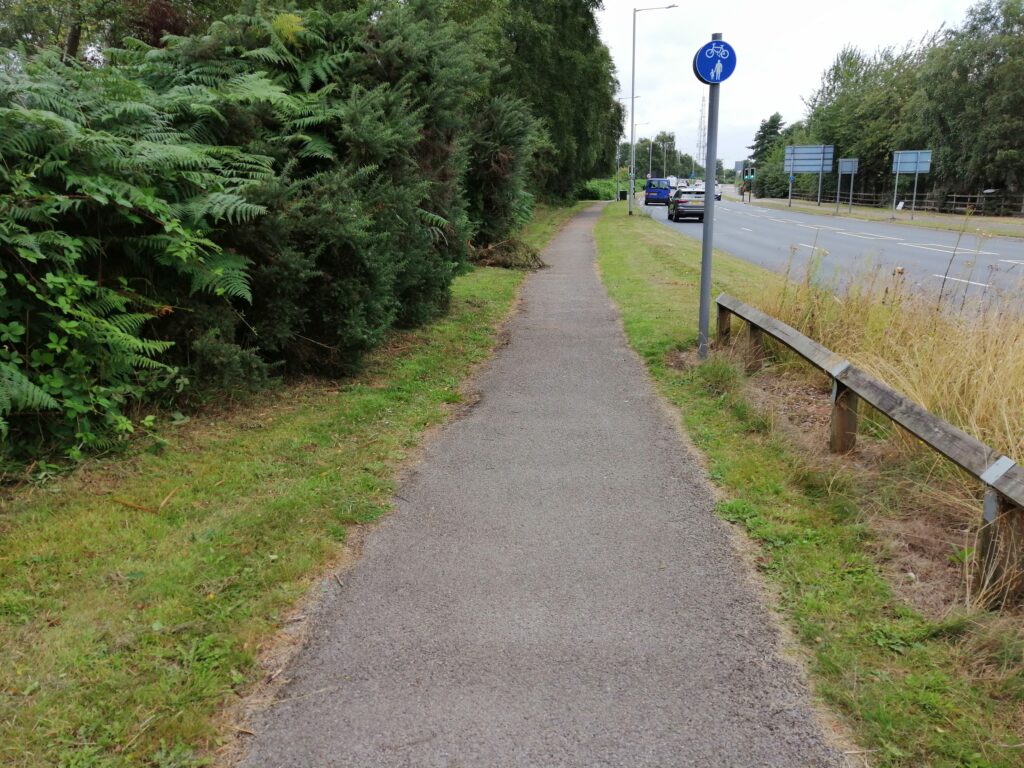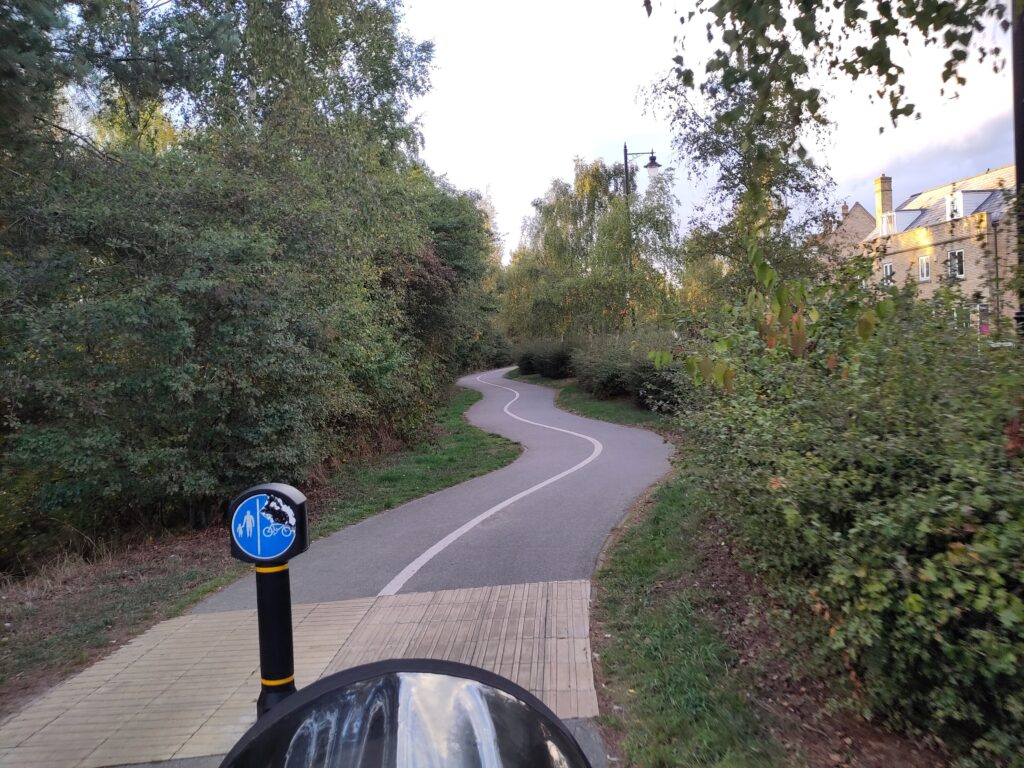Tom Hunt, MP for Ipswich, is in the local newspaper again looking for another access to the Ravenswood estate to try and solve the congestion problems in the area.1. Creating a new access to the estate will simply generate yet more motor traffic and congestion in the long term thanks to induced demand. There will then be the same issue again in a few years down the line, so alternatives really need to be looked at instead. Questions need to be asked about why the alternatives are not more popular already, and then solutions worked to make it them much more popular.
The alternatives to driving in the local area are walking, cycling, bus, and for longer journeys the train or coach. Let’s take a look at them in turn as to why they may not be so popular with some idea on how to improve them.
Walking
Walking to the nearby shops on the edge of the estate is reasonably pleasant, however going a littler further and you have to put up with really heavy motor traffic, difficulties crossing roads due to high levels of motor traffic, thus having to wait a significant time for a gap in the traffic. Some of the walking routes are signed as shared use with people cycling, which creates a conflict and discourages walking and cycling.
Some nearby main roads have had issues with getting the vegetation cut back, though that has become less of an issue recently, however once someones had a bad experience in an area they’ll avoid it longer term. Maintenance of vegetation is such an important thing that needs to be kept on top of, yet many councils and private land owners simply won’t, don’t have the funding to, or will avoid the cost. Often instead taking out the vegetations and putting in something that requires less maintenance, which then has other environmental issue such as poorer drainage and air pollution sadly happens.

Cycling
Ravenswood is a relatively recent development since the closure of the Ipswich Airport in 1996. It’s got National Cycle Route 51 through the estate, however it’s a very wiggly shared use, with limited connections to the housing it serves. It is also narrow, with the width of the cycle side so narrow you can’t pass another bike whilst staying within the cycle side so have to go on to the pedestrian side. Maybe the white line should be removed? Or the path made wider.

The key through route should also be made straighter. We don’t build motorways and similar such roads with sharp turns and wiggles, so why is cycle infrastructure built this way? The main road route being wiggly is fine, as we want to slow the cars through the residential area, however this discourages active travel use when applied to cycle infrastructure.
Bus
There are 2 bus routes that pass through the estate, they are the Ipswich Buses 1 and 2. They both connect to the town centre via partly different routes. In the other direction, the 2 goes round to the hospital, and the 1 stops at the nearby shopping area.
In terms of operating frequency, the 2 routes during the Monday to Saturday daytime (until about 7pm) they each run half hourly timed so that they are off set from each other making a roughly every 15 minute service on the parts of the route that overlap. In the evenings and on Sundays on the route 2 operates at an hourly frequency. The 1 doesn’t operate in the evenings or on Sundays.
This low frequency for an urban area isn’t going to encourage people to travel by bus. For a proper turn up an go service they need to operate at least every 10 minutes, ideally more frequently. Then you don’t need to consider the timetable as a passenger. At the hourly frequency it can often be faster to walk than to take the bus, especially when you have just missed one.
By walking outside the area there are other routes and connections available such as First Bus through to Felixstowe. However the connections through to Felixstowe are now less frequent than they used to be. They used to be every 15 mins daytime and half hourly in the evening. Now it’s only every 20 mins daytime and then hourly in the evening.
For journeys between Ravenswood and the town centre the only cross operator ticketing that I’m aware of is the Plusbus scheme, however that is only valid if you have a train ticket for the same period. The lack of cross operator ticketing really reduces the flexibility for travellers, or means that they need to buy multiple period tickets or just buy singles for whichever bus comes along even if it would overall work out more expensive. Competition doesn’t work on local public transport services at the point of use.
Just outside Ravenswood is a major sports and gymnastics centre. The car park is regularly full to overflowing with capacity issues. There really needs to be questions asked what would get more people travelling there via alternative means. This would help to reduce the air pollution which can’t be good for the people, especially children, going to train there.
Train
There are direct trains from Ipswich to various places such London, Norwich, Felixstowe, Cambridge, and Peterborough. However still have to get to the train station without using a car. The buses require you to change bus in the centre of town, which is particularly painful due to the low hourly frequency in the evenings and Sundays, daytime is less of an issue but will still put people off due to the combination of infrequency and lack of cross operator ticketing – you have to plan ahead if you want to use a plusbus ticket as you can’t get them as a mobile of smart ticket, they are still paper tickets that need to be picked up from the station or from a train guard.
Another problem with the train ticketing is day trips to London often require splitting to get the cheapest fare in Colchester or Manningtree. Splitting the fare can save around £5. Fares need to be updated so that the splitting is no longer required to get the cheapest fare (ideally by reducing the rather high cost of fares for those travelling north of Manningtree).
You can take bikes on trains, however any intercity services between Norwich and London requires a reservation. Other shorter stopping services don’t require a reservation and are instead simply first come first served. Taking a bike on the train opens up many more journey opportunities, especially when there is no or poor public transport at the destination.
The new trains have made taking bikes on trains much easier, especially the Stadlers with the level boarding. Even young children can wheel their bikes on to the trains, unlike other trains which have a step up, thus requiring help to get on. This helps to make the boarding and disembarkation quicker and less stressful. All new trains should have level boarding.
The frequency and speed of journeys to Cambridge, one of the major employment centres in longish commuting distance is particularly long compared to driving. Driving to the science park can take around 1 hour, whilst taking the train would be a minimum of 1 hour 20 minutes plus time to get to the station and any waiting time, especially if you are making a connection to Cambridge North in either Cambridge or Ely. Granted you can work whilst on the train, however the low hourly frequency, long journey time, combined with other difficulties getting to the station will be enough to put many people off taking the train.
Coach
Limited services by National Express from the town centre to Colchester, Stansted Airport, and London; however have to get there, typically on an infrequent bus, find someone to drive you, or take a taxi. The main competition is the train in terms of public transport.
Conclusion
The alternatives to driving simply are not attractive enough to encourage people out of their cars and get using public transport, walk, or cycle. There needs to be a proper review and significant improvements to the alternatives to driving before any more road building or opening up of other accesses to the area is considered. This review needs to take account of local journeys on the estate, into the local area, and longer regional journeys. Potentially even international journeys for when people would take holidays or visit friends and family in other countries, or for work.
Having grown up in Edinburgh and lived for 4 years in London, I’ve probably been spoilt by high frequency bus services, which are a true turn up and go nature.
Footnotes
- Sorry I’m a bit slow at completing this blog post. Joys of having young kids, and the bigger change of a house move over the past year.